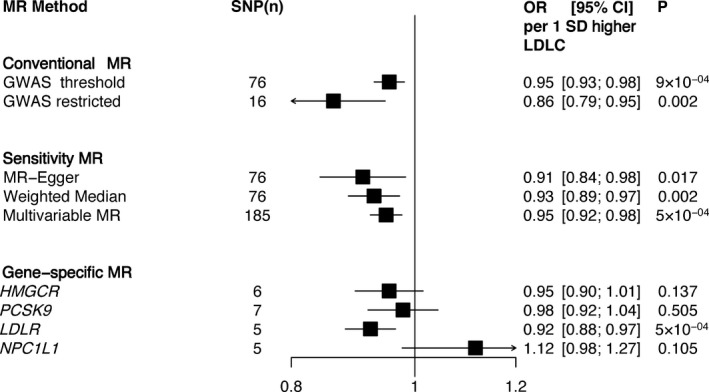Figure 2.

Association between genetic predisposition for elevated low‐density lipoprotein cholesterol (LDLC) and osteoarthritis (OA) in the UK Biobank. Odds ratios (ORs) and 95% confidence intervals (95% CIs) for OA using 2‐sample Mendelian randomization (MR) analyses in the UK Biobank are shown. Conventional MR estimates were obtained by analyzing polygenic risk scores for LDL cholesterol created from single‐nucleotide polymorphisms (SNPs) identified in genome‐wide association studies (GWAS) and gene‐specific SNPs related to OA in the UK Biobank weighted by SNP–LDL cholesterol associations in the Global Lipids Genetics Consortium 28. In the conventional MR analysis, for “GWAS threshold,” the polygenic risk score for LDL cholesterol was created using SNPs that were previously associated with LDL cholesterol at the GWAS significance level (P < 5 × 10−8) in the Global Lipids Genetics Consortium 28. For “GWAS restricted,” the polygenic risk score for LDL cholesterol was created using SNPs that were previously associated with LDL cholesterol at the GWAS significance level (P < 5 × 10−8) and were not associated with either HDL cholesterol level or triglycerides (P > 0.05) in the Global Lipids Genetics Consortium 28. Two‐sample sensitivity MR analyses were performed using MR‐Egger 34, weighted median MR 35, and multivariable MR 32 using summary SNP exposure data from the Global Lipids Genetic Consortium 28 and summary SNP outcome data from the UK Biobank. Genes for the gene‐specific analyses (HMGCR,PCSK9,LDLR, and NPC1L1) were mainly selected due to the fact that they encode for LDL cholesterol–lowering targets. Gene‐specific analyses indicated a lower risk of OA by LDLR‐mediated higher LDL cholesterol level. A similar trend was observed with the HMGCR instrument, although it did not reach statistical significance. MR indicated that a genetically predicted elevation in LDL cholesterol level decreases the risk of OA.
